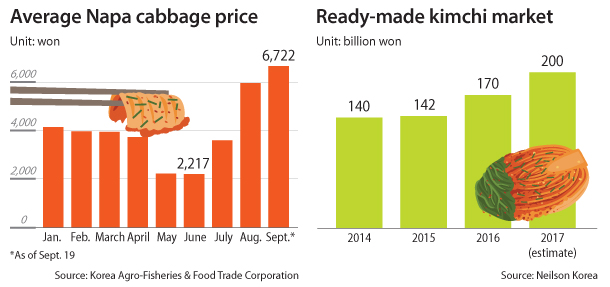More consumers turn to ready-made kimchi

But last week, she bought 10 kilograms (22 pounds) of ready-made kimchi for the first time in her life. Park ordered the kimchi online from a website that allows consumers to select the type and the amount of fermented seafood and chili powder that goes into the recipe.
“The kimchi that I made last year has run out and making more seemed like too much work this time,” she said. “The ready-made kimchi I tried in the past was too salty for my taste, but after adjusting the salt content, the one I recently received was pretty good so I plan to use the service more often.”
The leading ready-made kimchi manufacturer in Korea is Chongga, which launched in 1987. The 270 employees at its Hoengseong factory produce a number of different types of kimchi, but the spicy kind made from napa cabbage is by far the most common.
Around 100 workers have recently been preparing the kimchi, painstakingly peeling back every leaf on salted cabbages and stuffing each individual layer with chili paste.
The production line works for about 10 hours a day, but this has been insufficient to match the hike in orders that started in July.
This factory alone produces napa cabbage kimchi at a rate of about 100 tons a day. This is equivalent to over 33,000 napa cabbages. “It’s my 10th year working here but I’ve never seen the factory so busy,” said Lee Eun-hee, who overlooks quality assurance at the Hoengseong facility.
Ready-made kimchi is seeing a boost in sales as a lot of families find that their kimchi supplies are starting to run dry. Kimchi is normally prepared in bulk in the kimchi-making season, or kimjang, in early winter and stored and used throughout the year.
“As the kimchi-making season won’t arrive for another two months or so, consumers are turning to ready-made products to fill that void rather than making more before then,” said Moon Sung-joon, head of the kimchi team at Chongga.
Demand for kimchi had been decreasing since the early 2000s, largely due to the burgeoning popularity of Western food and restaurants among the public. A recent surge in the popularity of cooking at home, however, has brought the traditional side dish back to the Korean dining table.
The rise of single households is another reason for the increasing demand.
Kimchi requires a lot of ingredients, which is why people prefer to make it in a large quantities and store it throughout the year or share it with other family members. The ready-made kimchi market in Korea is worth 170 billion won ($150.5 million) as of last year, according to the research firm Nielson Korea.
CJ CheilJedang added Bibigo Kimchi to its portfolio last year. The food giant acquired a smaller brand called “Ha Sun Jung Kimchi” in 2007 but maintained a small market share of around 10 percent. Last year, its performance in the sector was much better, having raked in 36.3 billion won - 90 percent higher than 2015’s 18.9 billion won. Sales for this year already surpassed 30 billion won as of June.
Nongmard, an e-commerce site that specializes in agricultural products, saw kimchi sales shoot up 260 percent this year compared to 2016.
Another big contributor to the recent popularity of ready-made kimchi is higher napa cabbage prices. The monthly average price in September is 6,722 won per unit, according to statistics from the Korea Agro-Fisheries & Food Trade Corporation. This is almost triple June’s average of 2,217 won. Adding other ingredients like radish, chili powder, fermented seafood and scallions, the average cost for kimchi from one napa cabbage is 10,000 won to 15,000 won.
The price of ready-made kimchi is between 10,000 won and 18,000 won for three kilograms. The average napa cabbage weighs between two and three kilograms.
Kimchi manufacturers purchase napa cabbages on yearly contracts by leasing a whole cabbage field. In other words, they are not affected by fluctuating cabbage prices.
Considering that kimchi is made in large quantities and will generally take a whole family at least one day to produce, ready-made kimchi is not a bad deal.
“Kimchi making is a tough process and there’s hardly any price difference from home-made and ready-made - we see this as a factor in the recent demand uplift,” said Shin Yoo-jin, head of fresh food marketing at CJ CheilJedang.
Whereas in the past most ready-made kimchi was the conventional spicy version made from napa cabbages, manufacturers have recently been turning to other less common varieties. The expanded lineup includes white kimchi made without chili powder and kimchi made with radish, mustard greens or scallions as the base ingredient.
BY CHOI HYUN-JOO, SONG KYOUNG-SON [song.kyoungson@joongang.co.kr]










with the Korea JoongAng Daily
To write comments, please log in to one of the accounts.
Standards Board Policy (0/250자)